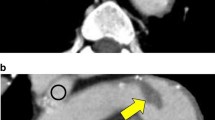Abstract
Background
A common complication of central catheters is vascular thrombosis. We have observed that the remaining thrombus can sonographically simulate the appearance of the catheter itself, suggesting that the catheter may have broken.
Objective
To describe the difference in the sonographic appearance of an intravascular linear thrombus and a retained catheter.
Patients and methods
The study comprised 11 infants who were born between 1 January 2000 and 31 December 2001 and had at least one sonographic examination after removal of a central venous or arterial catheter, in whom a residual thrombus had a sonographic appearance simulating the appearance of the catheter itself.
Results
In all of our cases the thrombus appeared as two parallel hyperechoic lines. In comparison to the sonographic appearance of a true catheter, these lines were less sharply demarcated, not quite geometrically parallel, less echogenic, and did not shadow or have reverberation artifacts.
Conclusions
Although the sonographic appearance of a residual linear thrombus may closely resemble the sonographic appearance of a retained catheter fragment, appreciation of the subtle differences between the two is important, and could obviate the necessity for more invasive procedures.

Similar content being viewed by others
References
Bhat R, Fisher E, Doshi U, et al (1981) Neonatal abdominal aortic thrombosis. Crit Care Med 9:858–861
Hogan MJ (1999) Neonatal vascular catheters and their complications. Radiol Clin North Am 37:1109–1125
Schmidt B (1997) The etiology, diagnosis and treatment of thrombotic disorders in newborn infants: a call for international and multi-institutional studies. Semin Perinatol 21:86–89
Hinson RM, Naulty C (1995) Use of central venous catheters is common in neonatal intensive care units. J Perinatol 15:519
Ross P Jr, Ehrenkranz R, Kleinman CS, et al (1989) Thrombus associated with central venous catheters in infants and children. J Pediatr Surg 24:253–256
Mehta S, Connors AF Jr, Danish EH, et al (1992) Incidence of thrombosis during central venous catheterization of newborns: a prospective study. J Pediatr Surg 27:18–22
Neubauer AP (1995) Percutaneous central i.v. access in the neonate: experience with 535 silastic catheters. Acta Paediatr 84:756–760
Kempley ST, Bennett S, Loftus BG, et al (1993) Randomized trial of umbilical arterial catheter position: clinical outcome. Acta Paediatr 82:173–176
Flanigan DP, Stolar CJ, Pringle KC, et al (1982) Aortic thrombosis after umbilical artery catheterization. Arch Surg 117:371–374
Fellmeth BD, Sandler MP, Thieme GA, et al (1986) Noninvasive evaluation of neonatal aortic thrombosis secondary to umbilical artery catheterization. AJR 146:619–620
Taber P, Lackey DA, Mikity V (1973) Roentgenographic findings of complications with neonatal umbilical vascular catheterization. Am J Roentgenol Radium Ther Nucl Med 118:49–57
Seibert JJ, Taylor BJ, Williamson SL, et al (1987) Sonographic detection of neonatal umbilical-artery thrombosis: clinical correlation. AJR 148:965–968
Fuenfer MM, Georgeson KE, Cain WS, et al (1998) Etiology and retrieval of retained central venous catheter fragments within the heart and great vessels of infants and children. Pediatr Surg 33:454–456
Courcoux MF, Jouvet P, Bonnet D, et al (2000) Intravascular rupture of a central venous catheter in a premature infant: retrieval by a nonsurgical technique. Arch Pediatr 7:267–270
Polos PG, Sahn SA (1991) Complication of central venous catheter insertion: fragmentation of a guidewire with pulmonary artery embolism. Crit Care Med 19:438–440
Simon-Fayard EE, Kroncke RS, Solarte D, et al (1997) Nonsurgical retrieval of embolized umbilical catheters in premature infants. J Perinatol 17:143–147
Deeg KH, Wolfel D, Rupprecht T (1992) Diagnosis of neonatal aortic thrombosis by colour coded Doppler sonography. Pediatr Radiol 22:62–63
Rand T, Kohlhauser C, Popow C, et al (1994) Sonographic detection of internal jugular vein thrombosis after central venous catheterization in the newborn period. Pediatr Radiol 24:577–580
Oppenheimer DA, Carroll BA, Garth KE (1982) Ultrasonic detection of complications following umbilical arterial catheterization in the neonate. Radiology 145:667–672
Author information
Authors and Affiliations
Corresponding author
Rights and permissions
About this article
Cite this article
Konen, O., Daneman, A., Traubici, J. et al. Intravascular linear thrombus after catheter removal: sonographic appearance mimicking retained catheter fragment. Pediatr Radiol 34, 125–129 (2004). https://doi.org/10.1007/s00247-003-1084-5
Received:
Revised:
Accepted:
Published:
Issue Date:
DOI: https://doi.org/10.1007/s00247-003-1084-5




